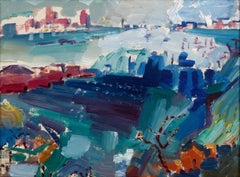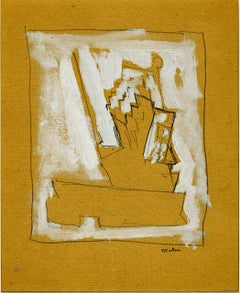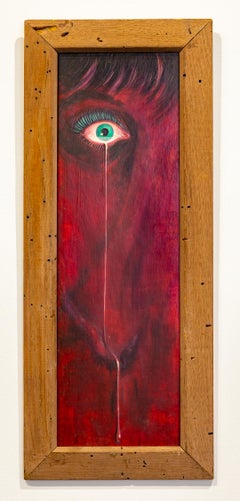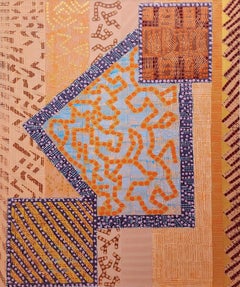John Marin Abstract Paintings
American, 1872-1953
John Marin was born in Rutherford, New Jersey in 1870. His father was a public accountant; his mother died nine days after his birth. He was taken to his maternal grandparents with whom he lived in Weehawken, New Jersey. His grandparents, with their son and two daughters were the only parents Marin was to know; it has been suggested that his father seems to have ignored him. As a child of seven or eight Marin began to sketch and when he was a teenager he had completed his earliest watercolors. His education in the schools of New Jersey was interspersed with summers of hunting, fishing and sketching; he traveled in the Catskills, and as far away as Wisconsin and Minnesota. But formal training was almost incidental to his development as an artist.
He is to America what Paul Cezanne was to France - an innovator who helped to oppose the influence of the narrative painters, the illustrators who were more interested in subject than form, in surface than substance. Marin brought to his work a combination of values which, at the turn of the century, was unique in this country: an aliveness of touch, colors that have both sparkle and solidity, and forms that are vibrant with an energy characteristic of our age.
Marin established himself as a practicing architect. In the early 1890s, he worked for four architects and by 1893 had designed six houses in Union Hill, New Jersey. At the age of twenty-eight, he decided to become a professional artist and studied briefly at the Pennsylvania Academy of Fine Arts in Philadelphia and the Art Students League in New York City.
As a watercolorist he had no equal. He used this fluid, spontaneous medium to abstract from objects - skyscrapers, boats, mountains and seas - a simplified anatomy of color and form and to define the pulsation of stresses and movements in the relationship of objects. It was a great disappointment, all his life, that his oil paintings did not achieve the popularity that his watercolors did.
From 1905 to 1910 he worked in Europe, where he was influenced by Whistler's watercolors. It was Alfred Stieglitz, Marin's lifetime friend and dealer, whose firm faith in his genius made his position in the art world possible. He developed a distinctive style that he used most characteristically in powerful watercolors of the Maine coast. During the 1920s he provided the dominant force in the movement away from naturalistic representation towards an art of expressive semi-abstraction.
He married Marie Jane Hughes after he returned to New York. They had one son, who grew up to run his father's considerable affairs. Marin continued to work at the same steady fast pace as long as he lived. Since 1908 he had produced 1700 paintings, an average of forty a year. He had made the frames for them as well. At the age of seventy-nine, he began to taper off from the days when he painted one hundred watercolors in a summer. He died in 1953.to
2
Overall Width
to
Overall Height
to
2
1
2
1
1
2
2
1
1
1
14
666
626
342
328
2
2
Artist: John Marin
Weehawken Sequence
By John Marin
Located in Bryn Mawr, PA
Weehawken Sequence, c. 1910-16
Oil on canvas board, 9 x 12 inches (22.9 x 30.5 cm)
Framed dimensions: 13 3/8 x 16 1/4 inches
John Marin’s long and prolific career is best marked by ...
Category
20th Century American Modern John Marin Abstract Paintings
Materials
Canvas, Oil, Board
Study for Mid-Manhattan II
By John Marin
Located in Fairlawn, OH
Study for Mid-Manhattan II
Oil and graphite on paper, mounted to board, 1932
Signed by the artist in pencil lower right
Sight size: 8 1/2 x 7 inches
One of a series of studies for th...
Category
1930s American Modern John Marin Abstract Paintings
Materials
Oil
Related Items
"Don't Cry Long" Abstracted and Distorted Self-Portrait, One Crying Eye
Located in Detroit, MI
"Don't Cry Long" is a self-portrait of the artist and an unusual one at that in which the artist portrays herself shedding tears. Perhaps it is an expression of some grief experienced by Ms. Woodlock, but it also admonishes her to not "Cry Long" while at the same time poking fun because of her elongated face and the one lone "long" tear tracing a pattern down her face. In addition to self-portraits, Ethelyn painted commissioned portraits. In this painting her head is cocked and her famous bangs hang down her forehead. Compare two self-portraits, “Up From Under”, and “M’Eyes" to "Don't Cry Long." The major differences are the close facial view and the brilliant blood red paint that fills the entire canvas.
This painting is included in the book, "Dreams Have Wings: An Artist's Journey into Magic and Mystery" printed in the United States, 1985. She describes "Don't Cry Long" as showing how funny looking we are, if we cry too long.
Ethelyn Woodlock...
Category
Mid-20th Century American Modern John Marin Abstract Paintings
Materials
Oil, Masonite
Divided By Time, Large Modern Abstract Painting
Located in Grand Rapids, MI
Robert Sealock (American, 20th Century)
Signed: RWS 93 (Canvas Verso)
" Divided By Time ", 1993
Oil on Canvas
48 1/4" x 40"
This large modern painting is in nice original condi...
Category
Late 20th Century American Modern John Marin Abstract Paintings
Materials
Canvas, Oil
Woman and Child in the Woods - Midcentury Abstracted Landscape in Oil on Canvas
Located in Soquel, CA
Woman and Child in the Woods - Midcentury Abstracted Landscape in Oil on Canvas
Dramatic abstracted painting of a woman holding a child in the woods by Maley (20th Century). This pi...
Category
1970s American Modern John Marin Abstract Paintings
Materials
Canvas, Oil, Stretcher Bars
$1,625 Sale Price
35% Off
H 26.5 in W 21 in D 1 in
Reclining Figures
By Otis Huband
Located in Dallas, TX
Born in 1933, Otis Huband declared his intention to be an artist at age 6. He earned his BFA and MFA at Richmond Professional Institute of the College of William & Mary, now Virginia...
Category
2010s American Modern John Marin Abstract Paintings
Materials
Canvas, Oil
Large Hudson River Figurative Modernist Landscape Oil Painting Edward Avedisian
By Edward Avedisian
Located in Surfside, FL
Edward Avedisian ( 1936-2007 )
Gouache or oil on paper, 3 guys around a car,
hand signed in paint lower left,
Measures 30"x 22.5"
Edward Avedisian (June 15, 1936, Lowell, Massachusetts – August 17, 2007, Philmont, New York) was an American abstract painter who came into prominence during the 1960s. His work was initially associated with Color field painting and in the late 1960s with Lyrical Abstraction and Abstract Expressionism.
He studied art at the School of the Museum of Fine Arts, Boston. By the late 1950s he moved to New York City. Between 1958 and 1963 Avedisian had six solo shows in New York. In 1958 he initially showed at the Hansa Gallery, then he had three shows at the Tibor de Nagy Gallery and in 1962 and 1963 at the Robert Elkon Gallery. He continued to show at the Robert Elkon Gallery almost every year until 1975.
During the 1960s his work was broadly visible in the contemporary art world. He joined the dynamic art scene in Greenwich Village, frequenting the Cedar Tavern on Tenth Street, associating with the critic Clement Greenberg, and joining a new generation of abstract artists, such as Darby Bannard, Kenneth Noland, Jules Olitski, and Larry Poons.
Avedisian was among the leading figures to emerge in the New York art world during the 1960s. An artist who mixed the hot colors of Pop Art with the cool, more analytical qualities of Color Field painting, he was instrumental in the exploration of new abstract methods to examine the primacy of optical experience.
One of his paintings was appeared on the cover of Artforum, in 1969, his work was included in the 1965 Op Art The Responsive Eye exhibition at the Museum of Modern Art and in four annuals at the Whitney Museum of American Art. His paintings were widely sought after by collectors and acquired by major museums in New York and elsewhere. He has been exhibited in prominent galleries, such as the Anita Shapolsky Gallery and the Berry Campbell Gallery in New York City. Edward Avedisian was known for his brightly colored, boldly composed canvases that combined Minimalism's rigor, Pop art exuberance and the saturated tones of Color Field painting.
Roberta Smith of the NYT writes of Avedesian: "Edward Avedisian helped establish the hotly colored, but emotionally cool, abstract painting that succeeded Abstract Expressionism in the early 1960s. This young luminary harnessed elements of minimalism, pop, and color field painting to create prominent works of epic proportions that energized the New York art scene of the time." In 1996 Avedisian showed his paintings from the 1960s at the Mitchell Algus Gallery, then in SoHo. His last show, dominated by recent landscapes, was in 2003 at the Algus gallery, now in Chelsea.
Selected Exhibitions:
Op Art: The Responsive Eye, at the Museum of Modern Art,
Whitney Museum’s Young America 1965
Expo 67, held in Montreal, Canada.
Six Painters (along with Darby Bannard, Dan Christensen, Ron Davis...
Category
20th Century American Modern John Marin Abstract Paintings
Materials
Oil, Gouache, Archival Paper
"Shrimp"
By Bror Julius Olsson Nordfeldt
Located in Lambertville, NJ
Signed Lower Right
Bror Julius Olsson “B.J.O.” Nordfeldt (1878 - 1955)
Bror Julius Olsson was born in Tullstrop, Sweden in 1878. He immigrated to the United States in 1891, later adopting his mother’s maiden name of Nordfeldt. Beginning his art studies at the Art Institute of Chicago where he was chosen to assist fellow artist, Albert Herter, with a large mural project for the McCormick Harvester Company. In 1900, he was sent to Paris by McCormick to help set up the completed mural at the Paris Exposition. While there, he studied briefly at the Academie Julian before traveling to England to study woodblock printmaking under F. Morley Fletcher. Returning to Chicago in 1903, Nordfeldt would spend the next ten years painting mainly figurative works in an academic style similar to that of the Old Masters. By the mid-teens he had developed a bold dramatic modernist style and divided his time between New York and Provincetown, Massachusetts. There, he invented the “Provincetown Print...
Category
1940s American Modern John Marin Abstract Paintings
Materials
Canvas, Oil
Shanty Town
By Robert Noel Blair
Located in Buffalo, NY
You are viewing a modernist American acrylic painting depicting a charming but rundown seaside town at night.
Robert Noel Blair (American, 1912-2003) was an American artist, paint...
Category
1950s American Modern John Marin Abstract Paintings
Materials
Acrylic, Archival Paper
Untitled
By James Koenig
Located in Buffalo, NY
An original oil on canvas painting by American artist James Koenig created in 1944.
Category
1940s American Modern John Marin Abstract Paintings
Materials
Canvas, Oil
Large Mid-Century Modern Abstract Cityscape Painting by Henriette Yetti Stolz
Located in Denver, CO
This dramatic mid-century oil and spackle painting by Henriette “Yetti” Stolz (American, 20th century) presents a bold abstract interpretation of a cityscape, featuring a dynamic bri...
Category
Mid-20th Century American Modern John Marin Abstract Paintings
Materials
Oil, Putty
Henriette "Yetti" StolzLarge Mid-Century Modern Abstract Cityscape Painting by Henriette Yetti Stolz
$5,800 Sale Price
20% Off
H 25.75 in W 61.75 in D 1 in
"Backstage, Ambassador" Broadway Theatre NYC Mid-century Modern Modernist Cubist
By Sam Norkin
Located in New York, NY
"Backstage, Ambassador" Broadway Theatre NYC Mid-century Modern Modernist CubistSigned lower left, titled on the stretcher.
Norkin was a Brooklyn, Ne...
Category
1940s American Modern John Marin Abstract Paintings
Materials
Canvas, Oil
Abstract
Located in Los Angeles, CA
This painting is part of our exhibition Charles Goeller: A Wistful Loneliness.
Oil on canvas, 29 x 22 inches, Signed on frame verso “Painted by Charles L. Goeller”
Exhibited:
(Perh...
Category
1930s American Modern John Marin Abstract Paintings
Materials
Oil
A Dynamic Mid-Century Modern Horse Race Painting by Chicago Artist, Rudolph Pen
Located in Chicago, IL
A dynamic, Mid-Century Modern horse race painting by noted Chicago artist, Rudolph Pen. Artwork size: 27" x 23"; Framed size: 27 1/2" x 23 1/2". Signed "Pen" lower right. Provenan...
Category
Mid-20th Century American Modern John Marin Abstract Paintings
Materials
Masonite, Oil
$1,600
H 27 in W 23 in D 2 in
John Marin abstract paintings for sale on 1stDibs.
Find a wide variety of authentic John Marin abstract paintings available for sale on 1stDibs. You can also browse by medium to find art by John Marin in oil paint, paint and more. Much of the original work by this artist or collective was created during the 1930s and is mostly associated with the modern style. Not every interior allows for large John Marin abstract paintings, so small editions measuring 7 inches across are available. Customers who are interested in this artist might also find the work of Clarence Holbrook Carter, David Hayes, and Donald Stacy. John Marin abstract paintings prices can differ depending upon medium, time period and other attributes. On 1stDibs, the price for these items starts at $15,000 and tops out at $15,000, while the average work can sell for $15,000.



